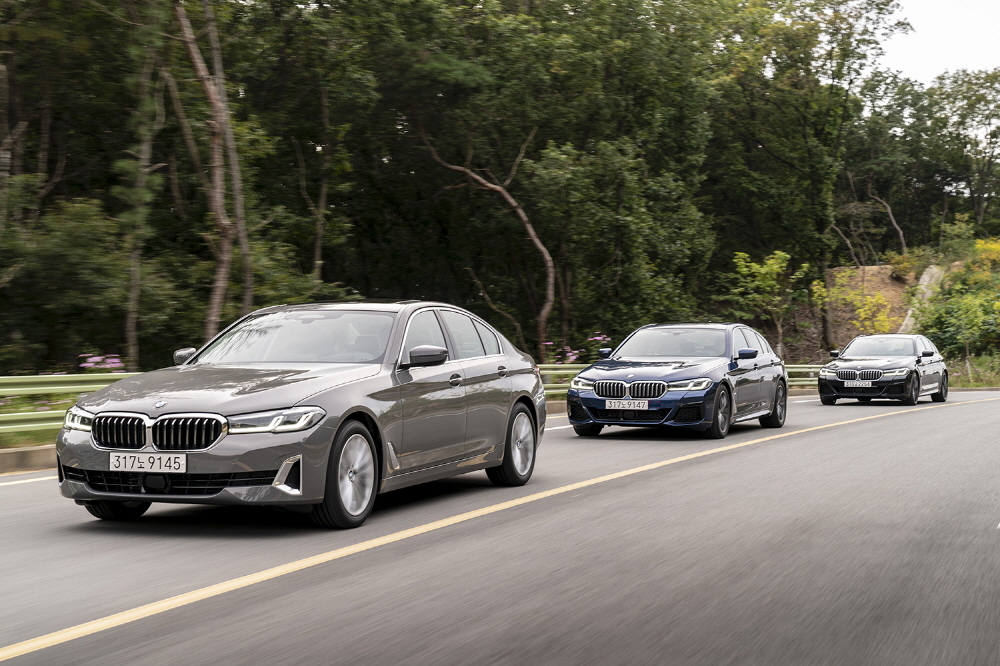 |
BMW 5 Series (BMW Korea) |
BMW Korea once led the foreign car market here, dating as far back as the importers association started to record sales in 2003 -- at least most of the time, until Mercedes-Benz took over in 2016.
Now, BMW is stepping up its game against the archrival, with the revamped BMW 5 and 6 Gran Turismo Series.
The automaker is making clear its intention to take back the throne, as it launched the upgraded version of its bestselling models on Oct. 5, just a week before Mercedes-Benz presented the face-lifted E-Class model, its direct competition to the 5 and 6 Series.
The 5 Series has long been favored in South Korea, selling more than in any other country in the world.
Since its launch in 1972, the 5 Series has sold over 8 million units across the globe, according to BMW Korea. In Korea, the seventh generation of the 5 Series has sold over 77,000 units in the past four years, the automaker said.
The Korea Herald took the refreshed BMW 5 and 6 GT Series for a test drive for about 100 kilometers from Gwangju, Gyeonggi Province, to the royal mausoleum of King Sejong in nearby Yeoju and back again.
Steering the wheel of the 530i M Sport Package model, the driving performance was impressive, as the vehicle caught both stability and the immediate response of the powertrain.
 |
BMW 6 GT Series (BMW Korea) |
Big changes were made to the exterior design. The new 5 Series comes with L-shaped headlights, which the company says give a sharper impression of the car than the previous “angel eyes” that were rounder.
The new model also embraces a slightly larger version of the kidney grille, and the whole length of the vehicle grew 27 millimeters to 4,965 mm.
Inside the car, the screen on the vehicle’s console has been expanded to 12.3 inches from the previous 10.25 inches.
In the new 5 and 6 Series, enhanced driving assistance functions are installed as standard, in addition to the wide panoramic sunroof.
Driving on the highway, the Driving Assistant Professional was adequate, allowing drivers to take their hands off the steering wheel and only have the foot on the pedals.
The Driving Assist View on the digital cockpit shows the car and the surroundings, depicting cars and objects in 3D.
It also has a lane-keeping assistance alarm system that gives a visual warning to the driver when drifting out of the lane, but a noise alert system may also have been useful.
The rear drive assist is also a default function, and was very helpful when reversing in a narrow lane. The sensors and cameras attached took in the surroundings to independently carry out the steering maneuver, and the foot only had to work to keep the speed low.
The vehicles were responsive when they moved too close to another lane, automatically adjusting the steering wheel. But with the alarm system only lighting up on the digital cockpit, a sound alert system would also have been useful for drivers.

The 530i model facilitates a 2.0-liter twin turbo engine, which exerts up to 252 horsepower and a maximum torque of 35.7 kilogram-meters.
While both of the premium sedans are sporty in nature, the 6 Series felt more dynamic in that aspect. The engine sound was louder even when the driving mode was set for comfort, as compared to the 5 Series.
The 5 Series will be presented with a lineup of five gasoline models and two 48-volt mild hybrid diesels. A plug-in hybrid model 530e is also added to the portfolio. The price range for the 5 Series is 63.6 million won to 116.4 million won ($55,800-$102,100).
The 6 Series comes in two gasoline models, two diesel models and one mild hybrid diesel model. The gasoline 630d xDrive launched first in Korea. The price is 89.2 million won for the luxury trim and 92.2 million won for M Sports Package.
By Jo He-rim (
herim@heraldcorp.com)










